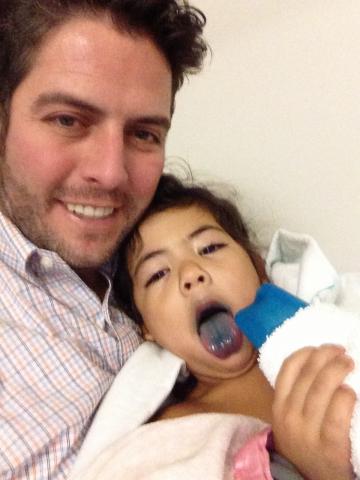Thank you, readers! Since beginning this series, we have received several response emails suggesting treatment plans for Grace -- all of them interesting and enlightening. Here’s hoping you’re sharing and discussing these entries with colleagues, patients and friends. It’s so important to observe our kids with a discerning eye while they sleep...and listen to what their breathing tells us.
NEXT TOPIC: Grace and her tonsils and adenoids. As you can see from these initial photos, Grace had a very small/narrow upper and lower arch.

Dr. Kevin Boyd, a Chicago-based Pediatrician remarked to me recently “We are all designed to have space for 32 teeth. Now we might not need our 3rd molars/wisdom teeth, but we still require room for all 32. We need to make sure we have adequate space for the tongue.”
Makes a lot of sense. In Grace’s case, that was the reason Drs. Olmos and Veis recommended removing her tonsils and adenoids immediately. The idea was to put something -- in this case, an R.P.E. (Rapid Palate Expander) -- in her mouth to help guide growth. We needed to make sure her airway was open as much as possible and that meant removing the tonsils and adenoids.
In the ‘50’s and ‘60’s (for those of you who remember), most everyone had their tonsils and adenoids removed early. The primary reason? Tonsillitis. Things were different by the time the ‘80s rolled around. Studies showed that removal didn’t decrease the likelihood of getting sore throats, so doctors limited the procedure to cases of severe inflammation.
 Acknowledgement of that historical development brings us back to Grace. It occurred to me that in her case there might be an unrecognized or not-seriously-considered benefit to removing her tonsils and adenoids. . . an open airway!
Acknowledgement of that historical development brings us back to Grace. It occurred to me that in her case there might be an unrecognized or not-seriously-considered benefit to removing her tonsils and adenoids. . . an open airway!
I found a 2011 NPR article by Nancy Shute on the resurgence of Tonsil- & Adenoidectomies titled Say Aaa! Then ZZZ: Tonsillectomy Helps Kids Sleep. It offers some insight into why the procedure fell out of favor and the reasons why it is important to consider in a new light when treating sleep disorders.
Certainly this procedure should not be performed without careful consideration -- we’re talking full anesthesia and possible complications. But in Grace’s situation, if we were going to help her sleep restfully, and if we were going to improve her growth and development (both mentally and physically) this had to be the first step.

Well actually this was the first step, but I’ll save that story for next time.


